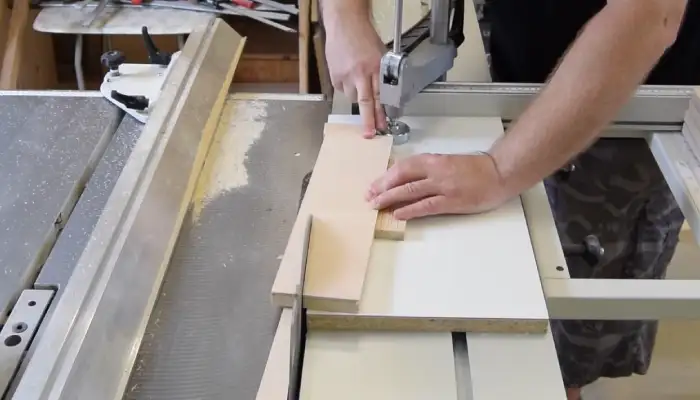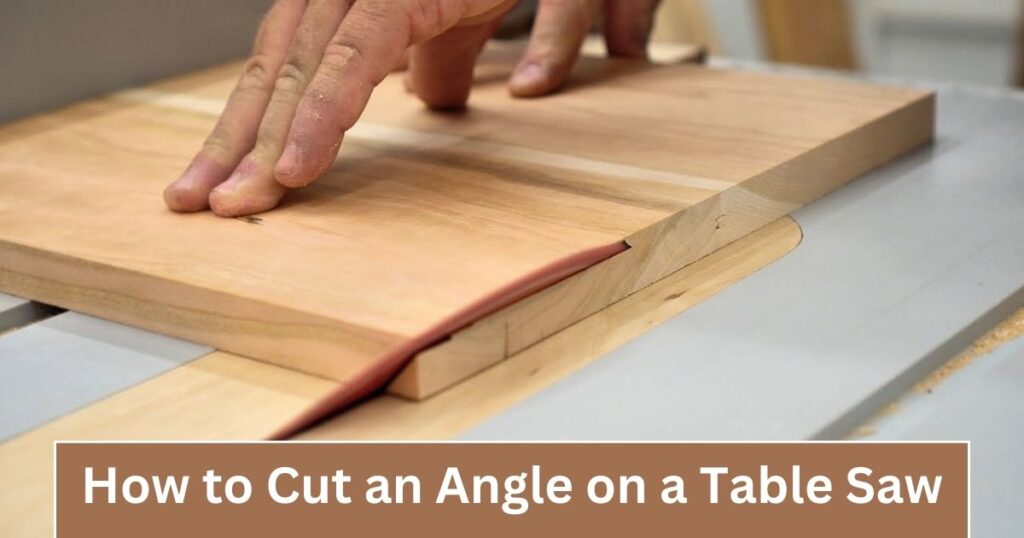The table saw is essential for most people who like to work with wood or do home projects. Most people love showing off their fancy table saws and hand tools, but not many can say they can make clean cuts.
Yes, the table saw can be scary at first, but if you practice and wait, you’ll be able to make clean cuts in no time.
We can help you if you’ve been having trouble with your table saw making clean cuts. Make sure you know these table saw cutting angle tips and tricks before you try them out for real.
As a result, this article will teach you how to cut angles on a table saw.
Recognize the Various Varieties of Table Saws:
There are three main types of table saws on the market: contractor, portable, and cabinet. Different types each have their features, pros, and cons. Before you buy, you should know what the changes are between each type.
Portable Saws:
Portable saws are ideal for light-duty undertakings and are the most cost-effective option. Due to their diminutive size and lightweight, they are effortlessly transported between task sites.
Contractor Table Saws:
Contractor table saws are marginally more expensive than portable variants, but they provide more power and features. Professionals and serious enthusiasts who require a versatile machine capable of handling heavy-duty tasks should consider purchasing one.
Cabinet Saws:
Although the most costly option, cabinet saws provide the most power and features. They are an excellent option for professionals in need of a robust machine capable of managing extensive undertakings.
Choose the Correct Blade:

Picking the right blade is one of the most important things you can do to make clean cuts. There are lots of different kinds of blades on the market, and each one is made for a certain job. Learn about the different types of blades available and choose the right one for your job.
When you pick out a blade, keep these things in mind:
Kind of Wood You’re Cutting:
While some blades are better at cutting softwoods, others are better at cutting hardwoods.
The Wood’s Thickness:
To keep the wood from breaking, a blade with more teeth is needed for thicker boards. When the blade cuts too deeply or too quickly, the wood splits.
The Desired Result:
If you want a smooth, clean cut, you’ll need a different type of blade than if you want a rough, jagged edge.
Kind Of Cut You Are Making:
You will need a different kind of blade if you want a rough, broken edge than if you want a smooth, clean cut.
For rip cuts, you need a different blade than for cross cuts. This is because each cut needs a different level of accuracy.
Set the Height of the Blade:
It’s time to set the blade height after picking out the right blade. How deep the cut is will depend on how high the blade is. There will be no deep cut if the blade is too high. You could damage your saw or get a kickback if the blade is too low.
To set the blade height, start by making the blade as tall as it can go. Next, bring the blade down until it’s just above the table by about an inch. Make the blade lock tighter to keep it in place once you’ve found the right height.
Set the Angle of the Blade:
The next step is to align the blade. Most of the time, rip cuts are made at 90 degrees and crosscuts are made at 45 degrees. However, the blade can be set to different angles, such as 30 or 60 degrees, based on the job.
Loosen the bevel lock button first to set the angle of the blade. Then, turn the blade to the position you want, and then pull the lever tight to keep it in place.
How to Cut an Angle on a Table Saw: 12 Tips and Tricks

When using a table saw to cut corners, here are some things you should do.
1. Use a Feather Board or a Push Stick:
The use of a push stick or feather board can help stop a kickback. Some tools, like push sticks, let you move the piece of work through the blade without touching it. A feather board is something that holds the piece of work steady as it goes through the blade.
2. For Cutting Longer Boards, use a Miter Gauge:
A miter measure is a piece of equipment that helps you cut straight lines. This helps a lot when cutting big boards. A miter gauge is easy to use. Just set it to the angle you want and clamp it in place. Then, line up the piece of work with the blade and push it through.
3. For Clean Cuts, Use a Fence:
A fence is something you can use to make straight rip cuts. It can be changed to different widths and is connected to the table saw. Line up the fence with the blade and clamp it in place to use it. Then, line up the piece of work with the blade and push it through.
4. Don’t Forget about Splitters:
A splitter is a tool that keeps the part from getting stuck on the blade, which also helps stop kickback. It can be changed to different widths and is connected to the table saw.
Line up the splitter with the blade and fix it in place to use it. Then, line up the piece of work with the blade and push it through.
5. Change the Cut’s Direction:
If cutting something doesn’t come out clean, try cutting it in a different way. If you’re trying to make a rip cut but the blade is getting stuck on the piece of work, try a crosscut instead. If that doesn’t work, turn the piece over and cut a cross-shape from the other side.
6. Do Not Rush:
It’s never a good idea to rush through a job. It’s important to take your time and make sure each cut is as precise as possible when making angles. You are more likely to mess up if you are in a hurry.
7. Make Sure the Cut Works First:
You should always test the cut on a scrap piece of wood before making the piece of work. In this way, you can be sure that the blade is at the right height and angle and that you are cutting correctly.
8. It is Better to Have a Sharp Blade:
A dull blade won’t cut as cleanly as a sharp one. Maybe it’s time to get a new blade if you need help making clean cuts. You could also try sharpening the blade, but that might not be enough based on how dull it is.
9. Make the Blade Move More Slowly:
The item could get stuck on the blade if it spins too fast, which could lead to kickback. To stop this from happening, slow down the blade by setting it to a slower speed or lowering the speed.
10. Slowly Feed the Piece:
The piece of work may get stuck on the blade if you move it too quickly through it. Keep moving it slowly through the blade instead. Make sure you’re not pushing the piece of work through the blade and that you’re applying even pressure.
11. Put up a Support Stand:
You can make long rip cuts with the help of a support stand. It can be changed to different widths and is connected to the table saw. Line up the support stand with the blade and clamp it in place to use it. Then, line up the piece of work with the blade and push it through. Remember to push it slowly so it doesn’t kick back.
12. Don’t Touch the Blade with Your Hands:
To avoid getting hurt, you should always keep your hands away from the blade. Take care not to touch the blade with your hands. Use a push stick or feather board instead.
Bottom Line: How To Cut Angles On a Table Saw
You will certainly be able to make angles and cuts that are completely flawless if you follow these recommendations. Please keep in mind that you should take your time, make use of the appropriate instruments and techniques, and remain safe.
And before you know it, you’ll be an expert when it comes to cutting angles with a table saw. When it comes to your woodworking endeavors, we wish you nothing but the best, and always remember that safety comes first!
FAQs about How To Cut Angles On a Table Saw
How Thick Can You Cut With a Table Saw?
This important part of table saws helps you make perfect rips every time. A 12-inch blade can cut through wood that is four inches thick, while a 10-inch blade can only cut through wood that is about three inches thick.
How To Measure Angles in Three Different Ways?
Several ways to measure an angle are in rotations, degrees, and radians. Sometimes radians are used instead of the other two units, but it is important to know how to change between them all.
How Sharp is the Tooth on a Table Saw Blade?
Picking the Correct Table Saw Blades Teeth with a strong hook cut more deeply. A general-purpose blade’s hook is usually between 15° and 20°, while a blade made just for ripping has a hook that is 20°.
To feed the workpiece, you need to apply more force when the hook angle is lower. There is no rake on some blades or even a negative rake.
Related Posts:
